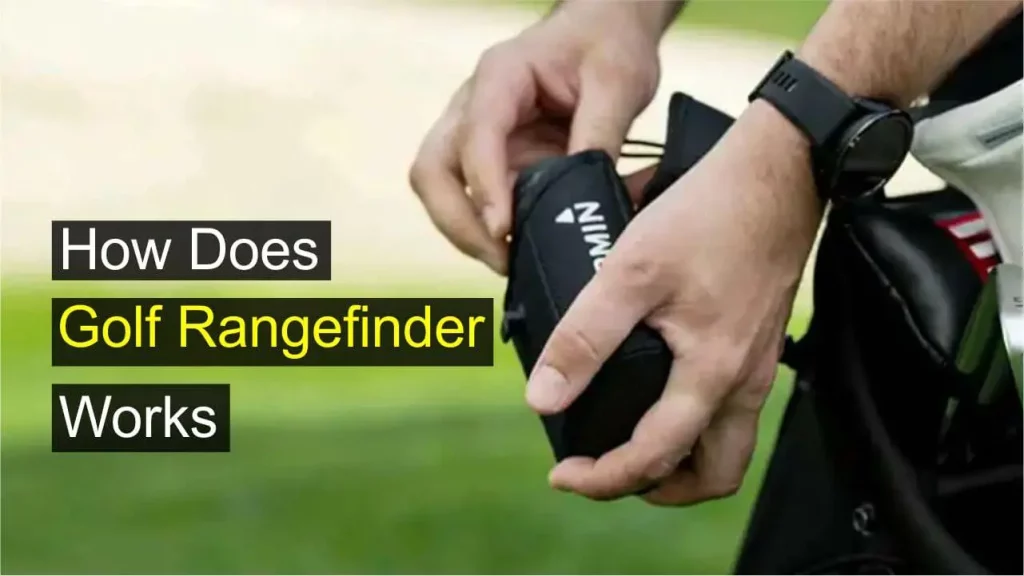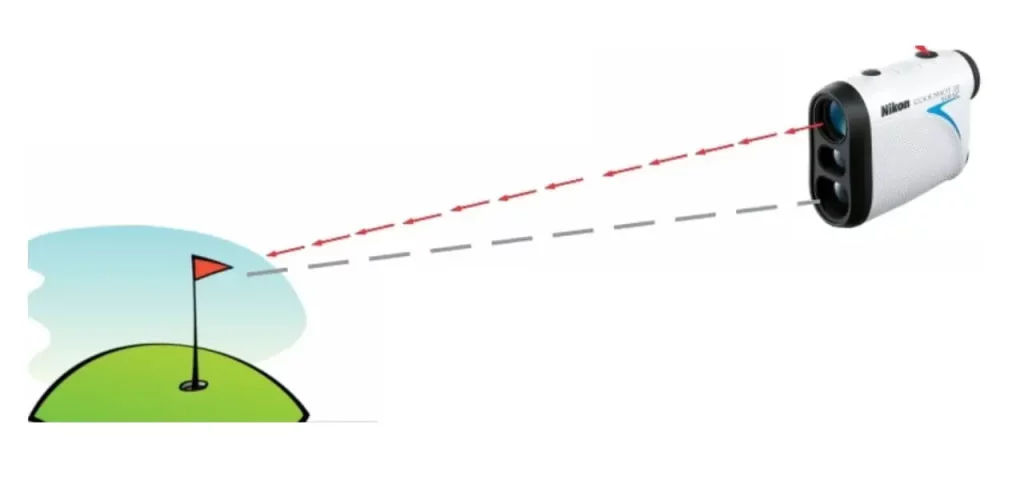Last Updated on September 2, 2023 by Ale Monti
Let’s consider that you’re out on the golf course, trying to hit that little white ball as accurately as you can. You need to know how far away the hole is so you can choose the right club and make the perfect shot. That’s where golf rangefinders come in! A golf rangefinder works by using lasers or GPS technology to accurately measure the distance from the golfer to a target on the course.
In this article, we’re going to talk about these special devices and learn how they work. We’ll discover three main types of rangefinders: GPS, optical, and laser. It’s like having secret golf helpers that tell you exactly how far you need to hit the ball. We’ll also look into the factors affecting measuring accuracy. So, let’s jump right into the article for the details:

How Do Different Types Of Rangefinders Work?
Rangefinders come in different types, and each type has its good things and not-so-good things. This is because they use different technologies. Let’s learn about how rangefinders work with these different technologies.
Laser Rangefinder
Laser rangefinders (LRF) are devices that use laser technology to precisely measure distances. When a laser beam reflects off a target and returns to the rangefinder, the gadget estimates the distance based on the time it takes for the laser to travel to the target and back. Laser rangefinders are routinely used to calculate distances with precision in a variety of applications, including golf, hunting, surveying, and military activities. They are preferred for their speed and precision in measuring distance.
How does a laser rangefinder work:
A laser rangefinder works in a rather easy manner. You point the gadget towards your target, then click a button to activate it. When triggered, the rangefinder releases a laser beam that travels to the target before returning to the device. For more details and in-depth knowledge, you can read our dedicated article about how does a laser rangefinder works.

The distance is calculated by the gadget, which is fitted with precision timing mechanisms, depending on the time it takes for the laser to return. The value of laser rangefinder accuracy and simplicity of use cannot be emphasized.
If the gadget fails to lock on to the target effectively, it may provide error messages or offer erroneous distance readings, thereby influencing the golfer’s club selection and shot execution.
GPS Rangefinder
A GPS rangefinder is a device that utilizes Global Positioning System (GPS) coordinates and satellite technology to accurately determine the location of objects or points on the Earth’s surface. These devices have achieved impressive levels of accuracy, often pinpointing locations within a few feet.
How a GPS Rangefinder Works:
It comes with golf course maps. However, in order for it to work properly, the course you’re playing on must be in its database. Then it talks with satellites in the sky, which tell it where you are on the golf course. Once it has determined your location, it estimates distances to important course features such as greens, fairways, and hazards. It then displays these distances, generally in yards or meters, so you may select the appropriate club and execute the precise shot. Some of the more advanced models can even compensate for slopes, providing you with extremely exact distances over difficult terrain. Some GPS rangefinders can also provide weather updates while you’re playing.
In a nutshell, a GPS rangefinder is like a high-tech device that helps you navigate the course with ease and accuracy.
Which one is better Laser or GPS Rangefinders:
Laser Rangefinders
Pros: Laser rangefinders provide accurate and swift distance readings, suitable for any golf course without the need for pre-downloaded maps. Some models can even adjust for slopes.
Cons: They can be slightly more challenging to use, requiring a steady hand and a clear view of the target. They come in various technological capabilities and price ranges.
GPS Rangefinders:
Pros: GPS rangefinders offer highly accurate distance readings and have tens of thousands of courses available on most devices. They often provide additional metrics and course information.
Cons: The golf course needs to be downloaded onto your device, and it must have been previously mapped and uploaded to the web. Some models may lack accurate updates, and there might be an ongoing subscription fee.
Ease of Use: GPS rangefinders are generally easier to use compared to laser rangefinders.
Optical rangefinders:
Optical rangefinders are not as widely used as laser or GPS rangefinders, but they do a good job. They have two lenses on one end. These lenses focus on the target and determine its height. They then utilize an integrated scale to tell you how far away it is. Its effectiveness is determined by how accurately you aim it at the target. However, they are not as good as GPS or laser rangefinders at this task, which is why most golfers prefer them.
Is a Laser Rangefinder Accurate?
Laser rangefinders use technology similar to autofocus cameras to accurately predict distances. They fire a laser beam at the target, which returns to the rangefinder. Because the laser moves at the speed of light, this technique is extremely quick, delivering distance values in seconds. Even among lower-priced alternatives, newer models have increased accuracy, with an average accuracy rating of one yard. Some more expensive versions provide even more accuracy, which might be useful for serious golfers in tournament play.
Laser Rangefinder Limitations:
Every laser rangefinder has a range rate that indicates how far the laser beam can go. The usual range of most models is four to five hundred yards, but higher-priced versions may reach eight hundred to one thousand yards. A greater range, however, does not always imply more power; it frequently reflects the quality of hardware and software. Premium rangefinders use higher technology, such as sophisticated sensors and computer chips that improve accuracy. These gadgets may also avoid obstructions such as trees in order to deliver exact distances. On courses with obstacles, cheaper rangefinders may struggle.
Which Type of Rangefinder is Right for You?
Depending on your preferences, you can choose between laser, optical, and GPS rangefinders. GPS systems are popular because of their preloaded golf course maps, but not all of them maintain their maps up to date. Changes to a course might result in incorrect readings. Laser rangefinders, on the other hand, are regarded as more adaptable and can function anywhere, independent of preloaded maps.
Factors Affecting The Accuracy Of The Rangefinder
Exactly, there are a few important factors that can affect the accuracy of a rangefinder:
- Quality and Size of the Lens: The lens quality and size can impact how clear the image is and how well the laser or waves can bounce off the target for accurate measurement.
- Weather Conditions: Bad weather, like rain, fog, or snow, can affect the rangefinder’s ability to send and receive the laser or waves, leading to less accurate measurements.
- Properties of Target: The type of target and how the rangefinder shows information is important. Some rangefinders have different colors or patterns you see when you look through them. This helps you aim better and know where to measure. The surface and material of the target can influence how well the laser or waves bounce back. Smooth and reflective surfaces provide better readings than rough or absorbent surfaces.
- Beam Divergence: The beam sent out by the rangefinder can spread out over long distances, which might make it hit areas other than the exact target point, affecting measurement accuracy.
- Vibrations: Holding a rangefinder steady is tough because our hands shake. For far targets, stable, rod-mounted rangefinders work well. Handheld ones need support, like leaning on something solid, for accurate measurements. No shakes mean more accurate results.
It’s important to be aware of these factors when using a golf rangefinder to ensure the most accurate measurements.
Conclusion
Golf rangefinders are vital for precision on the course, offering laser, GPS, and optical options. Laser rangefinders, using laser beams for swift and precise measurements, are popular for their speed and accuracy. GPS rangefinders, utilizing satellite technology, boast extensive course databases and added features like weather updates.
Optical rangefinders, though simpler, are less favored due to lower accuracy. The choice between laser and GPS rangefinders depends on personal preference and course database availability. Factors like lens quality, weather, target properties, beam spread, and vibrations can affect accuracy. Being aware of these variables ensures precise measurements. In essence, golf rangefinders enhance accuracy and confidence, elevating your golfing experience, whether you prefer laser speed or GPS convenience.
Frequently Asked Questions
- How do I choose the right golf rangefinder for my needs?
Consider factors like accuracy, ease of use, price, course database availability (for GPS rangefinders), and any additional features you may need, such as slope adjustment or weather updates.
- How does a golf rangefinder work?
Golf rangefinders work using either laser technology or GPS (Global Positioning System). Laser rangefinders emit a laser beam towards the target and calculate distance based on the time it takes for the laser to bounce back. GPS rangefinders rely on satellite signals and preloaded course maps to determine distances.
- How to use a rangefinder properly?
To use a rangefinder properly:
- Aim the rangefinder at your target.
- Press the button to activate the rangefinder’s laser or measurement.
- The rangefinder will emit a laser beam or waves, which will bounce off the target and return.
- The device will calculate the time it took for the beam/waves to travel and return, then display the distance on the screen.
- Make sure the rangefinder is stable while measuring, and avoid distractions that might interfere with the measurement.